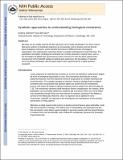Synthetic approaches to understanding biological constraints
Author(s)
Velenich, Andrea; Gore, Jeff
DownloadGore_Synthetic approaches.pdf (397.8Kb)
OPEN_ACCESS_POLICY
Open Access Policy
Creative Commons Attribution-Noncommercial-Share Alike
Terms of use
Metadata
Show full item recordAbstract
Microbes can be readily cultured and their genomes can be easily manipulated. For these reasons, laboratory systems of unicellular organisms are increasingly used to develop and test theories about biological constraints, which manifest themselves at different levels of biological organization, from optimal gene-expression levels to complex individual and social behaviors. The quantitative description of biological constraints has recently advanced in several areas, such as the formulation of global laws governing the entire economy of a cell, the direct experimental measurement of the trade-offs leading to optimal gene expression, the description of naturally occurring fitness landscapes, and the appreciation of the requirements for a stable bacterial ecosystem.
Date issued
2012-08Department
Massachusetts Institute of Technology. Department of PhysicsJournal
Current Opinion in Chemical Biology
Publisher
Elsevier B.V.
Citation
Velenich, Andrea, and Jeff Gore. “Synthetic Approaches to Understanding Biological Constraints.” Current Opinion in Chemical Biology 16, no. 3–4 (August 2012): 323–328.
Version: Author's final manuscript
ISSN
13675931